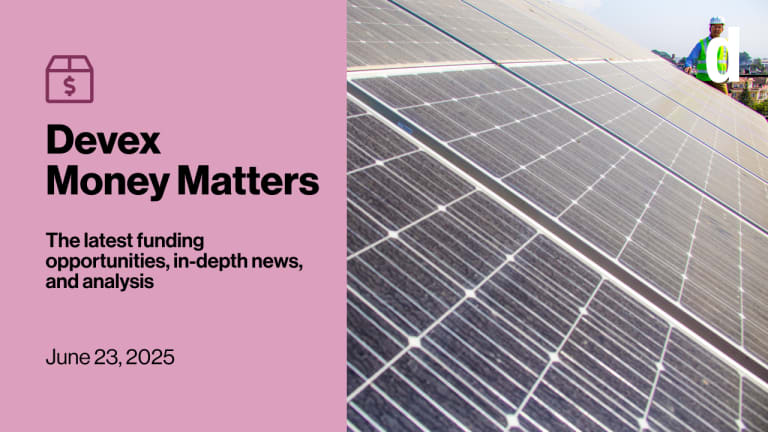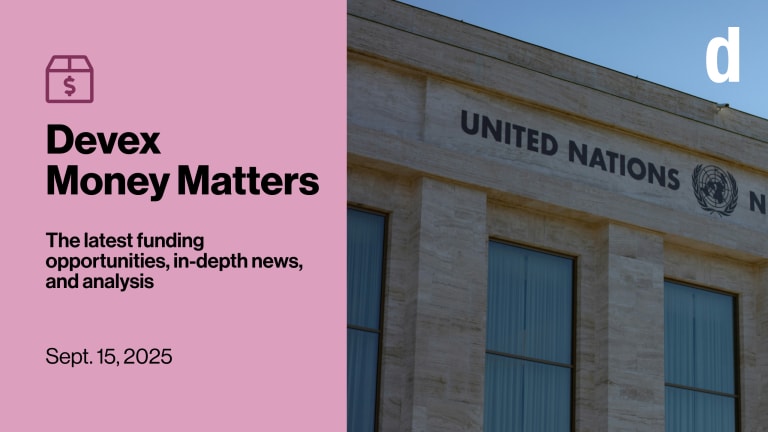
USAID awarded $6.8 billion in contract funding in the last financial year. But who won the business? Who were the new entrants in our top 10 list of the largest contractors?
+ Are there topics you want to read more about in Money Matters? We want your feedback.
Contract signs
USAID awarded $6.8 billion in contracts to 1,900 organizations in 2023 — down 14% in cash terms from the previous year.
This is a preview of Devex Money Matters
Sign up to this weekly newsletter and get the latest in development funding in your inbox every Monday.
But, as in previous years, a small number of organizations dominated, with almost half of the total going to just 10 suppliers.
That list of the largest contractors changed a little from last year, with two new entries. But has anyone succeeded in knocking Chemonics off the number one spot?
Read: Who were USAID's top contractors in 2023? (Pro)
+ Join us on Wednesday, June 12, for a Devex Pro Live panel discussion on what’s at stake for aid in the upcoming U.K. election. It will cover the main parties’ different visions for aid, how aid organizations should prepare for the new government, a Q&A session, and more. Save your spot now.
Funding activity
We publish tenders, grants, and other funding announcements on our Funding Platform. Here are some of the ones which have been viewed the most in the past 10 days.
South Korea has signed a framework agreement worth $2.5 billion to fund development infrastructure projects in Tanzania.
The Climate Investment Funds announced a $500 million financing package to help the Philippines switch from coal to renewable energy.
The European Bank for Reconstruction and Development announced €12.5 million ($13.4 million) in funding to support small and medium-sized enterprises in Lebanon to reduce waste and become more sustainable.
The U.S. Department of State announced a $1.23 million grant competition to implement a program to help women in Latin America advance their careers in clean energy and mining.
The European Union has allocated €1.2 million ($1.3 million) in humanitarian aid to assist with cyclone relief efforts in Bangladesh and India following the destruction of homes and essential supplies.
+ Try out Devex Pro Funding today with a free five-day trial, and explore funding opportunities from over 850 sources in addition to our analysis and news content.
Under pressure
A powerful U.S. lawmaker has fired off a series of in-depth questions to the leaders of USAID, asking for more information on the agency’s localization initiatives as well as the $17 billion NextGen global health supply chain suite of contracts.
Sen. Ben Cardin, chair of the U.S. Senate Foreign Relations Committee, said that the contracts offered an opportunity to shift to a more locally led approach.
Cardin, a Democrat representing Maryland, wrote to USAID Administrator Samantha Power in a May 16 letter published online by the advocacy group Unlock Aid.
Read: US lawmaker presses USAID chief on health supply chain localization
ICYMI: What's stopping USAID from localizing? (Pro)
+ Your Devex Pro membership lets you get the most out of our localization coverage and also access all our exclusive reporting and analyses, members-only events and networking opportunities, and the world’s largest globaldev job board.
Not yet gone Pro? Start your 15-day free trial today.
Golden handcuffs
Historically, many people had a picture of an aid worker as a European or American, thousands of miles from home, migrating from crisis to crisis. These workers used to need significant incentives to cross borders: a generous pay structure, health insurance, and private schools for the kids.
But today, more and more expatriate workers in the development sector are from the global south, and most are working in a country that borders their own. They’re doing so to take advantage of the legacy system which offers expats much better pay than locals.
But the problem is that when they want to take that experience home again, they can’t do so without taking a pay cut. Rebecca Root, writing for Devex, spoke to NGOs and recruiters who are wrestling to free these workers — and themselves — from the golden handcuffs.
Read: The rise of the global south expat — and why it's bad for localization (Pro)
+ This piece is part of our Roots of Change series where we explore the push to take locally led development from rhetoric to reality. Explore the series.
Going Dutch
We’ve seen aid budgets falling across Europe in recent months, and now it’s the turn of the Netherlands — the world’s seventh-largest donor in 2023 — to wield the axe.
An agreement published last month contains plans to cut official development assistance by €2.4 billion annually from 2027. The move follows elections last November, which saw the far-right Party for Freedom, or PVV, win the most votes. While PVV leader Geert Wilders won’t be the next prime minister, his party’s influence is clear in the decision.
There are still question marks about what the cuts will affect, writes my colleague Vince Chadwick, with security and sexual health both potentially on the chopping block.
Read: The Netherlands is cutting billions from aid. What happens next? (Pro)
Related: Why are billions being cut from European aid budgets? (Pro)
Supplemental questions
It was only a few weeks ago that the future of U.S. funding in Ukraine and Gaza looked in serious doubt. But a $95 billion bill, including billions for USAID and the U.S. Department of State, has helped address any short-term difficulties. But how did the bill get passed? How crucial a role did lobbying from the sector play?
Devex President and Editor-in-Chief Raj Kumar sat down with one of the leaders of the lobby movement to find out exactly what went on.
Watch: What did it take to get a $95B bill through a divided US Congress? (Pro)
+ Your Pro membership lets you get the most out of our coverage of the U.S. aid sector.
Sign up to Money Matters for an inside look at the biggest stories in development funding.








